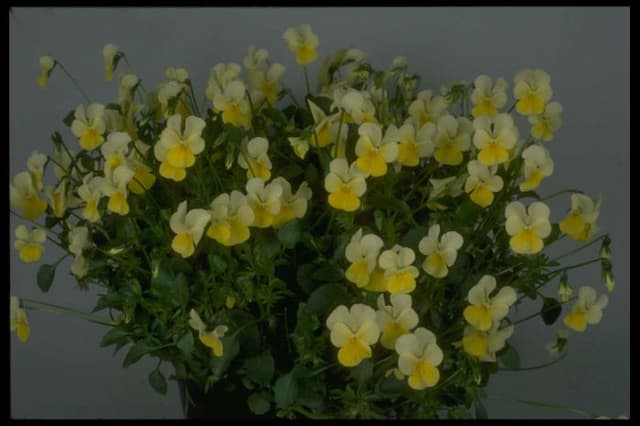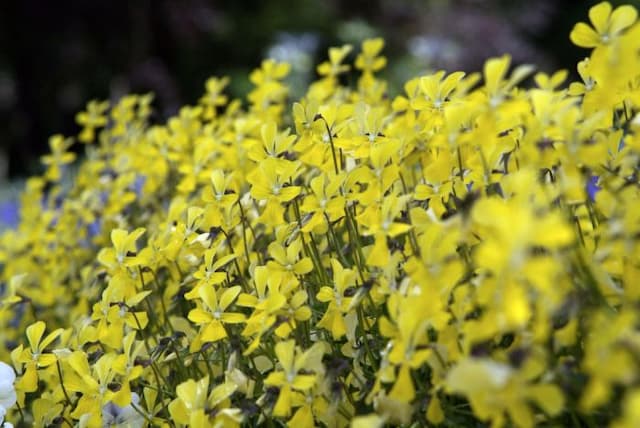Pansy Viola 'Bridie' (Va)

ABOUT
Viola 'Bridie', commonly referred to as a pansy, exhibits a charming and vibrant presence in the garden. Its most striking feature is its flowers, which present a delightful palette of colors, often showcasing deep purples, sunny yellows, and rich blues, sometimes with a bold splash of contrasting hues at their centers, creating a striking, whiskered effect. These flowers typically have five soft petals that can appear velvety in texture, with the lowermost petal often sporting a slight indentation that looks like a small notch. The foliage of Viola 'Bridie' is no less attractive, composed of green, heart-shaped leaves that form a low, lush mound beneath the flowers. The leaves are slightly ruffled along the edges, which contributes to the plant's overall ornamental charm. Twisting and turning gracefully on slender stems, the flowers nod gently under the breeze, presenting a dance of color that enlivens the garden throughout its blooming period.
About this plant
 Names
NamesFamily
Violaceae
Synonyms
Bridie's Viola
Common names
Viola 'Bridie' (Va)
 Toxicity
ToxicityTo humans
Generally, violas, including a variety like Viola 'Bridie', are not known to be toxic to humans. The most common name for plants in this genus is viola or pansy. They are often used in salads and desserts as edible flowers. However, as with any plant, individuals may have allergies or sensitivities that could cause mild stomach upset if ingested. It is always a good practice to avoid eating any plant unless you are certain it is safe to do so and violas from florists or nurseries may have been treated with pesticides not intended for consumption.
To pets
Violas, commonly known as violas or pansies, are not typically toxic to pets. They are often considered safe for dogs, cats, and other pets to be around, and even ingestion of small amounts is unlikely to cause more than mild gastrointestinal upset. However, it is always best to discourage pets from eating plants as individual animals may react differently, and plants treated with pesticides or other chemicals could be harmful.
 Characteristics
CharacteristicsLife cycle
Perennials
Foliage type
Evergreen
Color of leaves
Green
Flower color
Mixed
Height
6 inches (15 cm)
Spread
6 inches (15 cm)
Plant type
Herb
Hardiness zones
5
Native area
Europe
Benefits
 General Benefits
General Benefits- Ornamental Appeal: The Viola 'Bridie' offers vibrant blooms that enhance the aesthetic of gardens and outdoor spaces.
- Low Maintenance: It requires minimal care once established, making it ideal for busy gardeners.
- Versatility: This plant can be grown in containers, borders, or as ground cover, providing flexibility in garden design.
- Cold Tolerance: It is cold-hardy, withstanding cooler temperatures and still thriving.
- Pollinator Attraction: The flowers attract bees, butterflies, and other beneficial insects, promoting biodiversity.
- Long Blooming Season: With proper care, Viola 'Bridie' can provide color for much of the growing season.
- Edible Flowers: The blooms are edible and can be used to decorate salads and desserts, although they should be consumed in moderation.
- Compact Growth: Its compact size makes it suitable for small gardens or spaces.
 Medical Properties
Medical PropertiesThis plant is not used for medical purposes.
 Air-purifying Qualities
Air-purifying QualitiesThis plant is not specifically known for air purifying qualities.
 Other Uses
Other Uses- Ink Production: The petals of the Viola can be used to create a natural dye or ink for art, with variations in color depending on the pH level of the solution.
- Fabric Dye: Similarly, the dye extracted from Violas can be used to naturally tint fabrics with delicate shades of purples and blues.
- Floral Arrangements: Viola flowers can be crystallized with sugar and used to decorate cakes and desserts for an elegant touch.
- Ice Cubes: Freeze small Viola flowers in ice cube trays filled with water to create decorative ice cubes for refreshing drinks.
- Violin Crafting: Some luthiers might use viola flowers as decorative elements when crafting or repairing stringed instruments like violins.
- Viola Art: Pressed Viola flowers can be used to create botanical art pieces, bookmarks, or as part of scrapbooking projects.
- Natural Potpourri: Dried viola flowers can contribute to a fragrant potpourri mix to naturally scent rooms.
- Viola Syrup: By infusing sugar syrup with viola flowers, one can create a flavorful and aromatic syrup for use in cocktails or as a pancake topping.
- Gourmet Garnish: Fresh viola flowers can be used as a garnish on sophisticated dishes to enhance their visual appeal.
- Photography Props: Viola flowers can be used as delicate props in close-up photography or to create a colorful, natural backdrop.
Interesting Facts
 Feng Shui
Feng ShuiThe Pansy is not used in Feng Shui practice.
 Zodiac Sign Compitability
Zodiac Sign CompitabilityThe Pansy is not used in astrology practice.
 Plant Symbolism
Plant Symbolism- Modesty: The Viola, also commonly known as "Pansy" or "Violet," is often associated with modesty due to its small and unassuming appearance.
- Innocence: Its delicate structure can symbolize innocence, often evoking a sense of purity and simplicity.
- Affection: In Victorian floriography, giving a Viola expressed the sentiment of "thinking fondly" of someone, symbolizing tender affection.
- Remembrance: Violets are also tied to the idea of remembrance, making them a symbol for memories and keeping someone in your thoughts.
 Water
WaterPansies, including Viola 'Bridie', prefer consistently moist but not waterlogged soil. Generally, watering about 1 inch per week, spread out over a few days, is adequate. Use a watering can or a gentle stream from a hose to water the soil directly without splashing the foliage to prevent fungal diseases. During hot, dry spells, you may need to water pansies daily, especially if they're in containers. If the weather is cool and damp, you might cut back to watering just once every week or ten days.
 Light
LightPansies, including Viola 'Bridie', thrive best in full to partial sunlight. The ideal spot for them is an area that receives morning sun and some afternoon shade, particularly in hotter climates. These plants will bloom most prolifically when they receive at least 6 hours of direct sunlight per day.
 Temperature
TemperaturePansies like Viola 'Bridie' prefer cool weather and will flourish in temperatures ranging from 40°F to 60°F. They can survive light frosts and briefly tolerate temperatures as low as 20°F, but hot temperatures above 80°F will cause them to decline. The ideal growing conditions for pansies are in the cool temperatures of spring and fall.
 Pruning
PruningPansies like Viola 'Bridie' should be deadheaded regularly to encourage more blooms and prevent seeding. Prune away any faded or diseased flowers and leaves to maintain the plant's appearance and health. The best time for major pruning is just before new growth starts, often in early spring or fall, which helps rejuvenate the plants for the next bloom cycle.
 Cleaning
CleaningAs needed
 Soil
SoilFor Viola 'Bridie', commonly known as Pansy, the ideal soil mix is well-draining, fertile, and loamy with a good amount of organic matter like compost or peat moss. The pH should be slightly acidic to neutral, ranging from 6.0 to 7.0. An equal mix of potting soil, perlite, and peat moss can create a conducive growing environment for Pansies.
 Repotting
RepottingPansies, including Viola 'Bridie', generally do not require frequent repotting and can thrive in the same pot for several seasons. However, they should be repotted if they outgrow their current container or if the soil has become compacted and depleted of nutrients, typically every 1-2 years.
 Humidity & Misting
Humidity & MistingPansies, such as Viola 'Bridie', prefer moderate environmental humidity levels. Aim for a humidity level between 40% to 60% for optimal growth. Avoid conditions that are too humid to prevent fungal diseases, which Pansies can be prone to in overly moist environments.
 Suitable locations
Suitable locationsIndoor
Place Pansy in bright, indirect light and keep soil moist.
Outdoor
Plant in partial sun to full shade and water regularly.
Hardiness zone
6-9 USDA
 Life cycle
Life cycleViola 'Bridie' begins its life cycle as seeds that germinate in cool, moist soil, usually in early spring or fall. After germination, seedlings establish a small rosette of leaves at the soil level. The plant then enters a vegetative stage, where it produces more leaves and roots, and in the case of 'Bridie', possibly runners that can lead to vegetative propagation. Following the vegetative phase, 'Bridie' develops flower buds that bloom into the distinctive flowers commonly known as pansies, usually in spring, displaying a variety of colors and often a pleasant fragrance. After pollination, which can occur via insects or self-pollination, the pansy forms seed capsules that mature and eventually release seeds, completing the reproductive cycle. In many climates, Viola 'Bridie' behaves as an annual or biennial, meaning its life cycle can span one or two growing seasons, respectively.
 Propogation
PropogationPropogation time
Spring-Early Summer
Viola 'Bridie', commonly known as a type of Violet, is most popularly propagated through division, which is best done in the fall or early spring. To propagate by division, carefully dig up the entire plant, ensuring to keep as much of the root system intact as possible. Once the plant is out of the ground, use your hands or a sharp knife to gently separate the plant into smaller sections, making sure that each section has a portion of the root system attached. You can then replant these divisions immediately into well-prepared soil, ideally enriched with compost, setting them at the same depth they were previously growing. Water the new plants thoroughly after planting to help establish them. Given the appropriate care and environment, the divisions will grow into healthy plants that should flower the following season.









